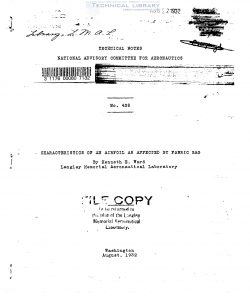naca-tn-428
- Version
- 120 Downloads
- 400.98 KB File Size
- 1 File Count
- November 24, 2016 Create Date
- November 24, 2016 Last Updated
National Advisory Committee for Aeronautics, Technical Notes - Characteristics of an Airfoil as Affected by Fabric Sag

This report presents the results of tests made at a
high value of the Reynolds Number in the N.A.C.A. variable-
density wind tunnel to determine the aerodynamic character—
istics of an airfo 1 as affected by fabric sag. Tests
were made of two Gottingen 387 airfoils, one having the
usual smooth surface and the other having a surface modi—
fied to simulate two types of fabric sag.
The results of these tests indicate that the usual
sagging of the wing covering between ribs has a very small
effect on the aerodynamic characteristics of an airfoil.
Prior to the present investigation, but few tests
have been made to determine the aerodynamic effects of
fabric sag in airplane wings. In connection with a study
of the lift coefficients of the wings of a full—sized air-
plane and of a model, the British Advisory Committee, in
1916, investigated the characteristics of the model air—
foil as affected by fabric sag. (Reference 1. ) From the
results of these tests they concluded that the effect of
the sag was not very great. In a later investigation,
Kumbruch in Germany (reference 2) arrived at the same con—
clusion and his tests at two values of the Reynolds Num—
ber indicated that the differences were even smaller at
the higher value of the Reynolds Number. These early
tests, however. were both made at comparatively low val-
ues of the Reynolds Number, and the effect of fabric sag
on the characteristics of actual wings was therefore not
definitely established. Rizzo (reference 3), in studying
the precision of wing sections, concluded that the slight
decrease in average thickness c'aused by the fabric sag
would have very little effect on the wing characteristics.
| File | Action |
|---|---|
| naca-tn-428 Characteristics of an Airfoil as Affected by Fabric Sag.pdf | Download |

Comment On This Post